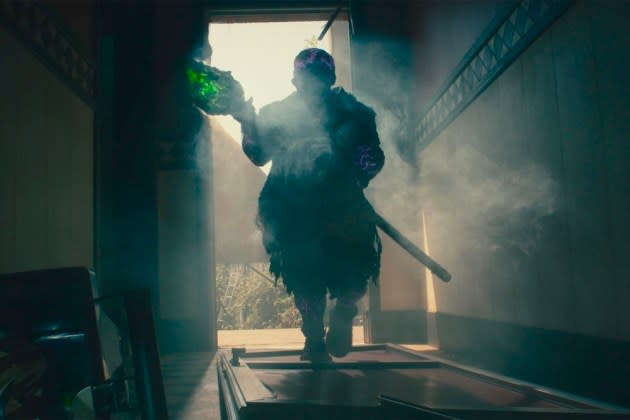‘The Toxic Avenger’ Review: Peter Dinklage Breathes New Life Into Troma’s Undying Franchise
- Oops!Something went wrong.Please try again later.
- Oops!Something went wrong.Please try again later.
- Oops!Something went wrong.Please try again later.

Much like its protagonist — a ghastly superhero who gains his powers after falling into a vat of chemical waste — “The Toxic Avenger” refuses to die. Made for a paltry $500,000 in 1984, Troma’s cult classic spawned three direct sequels, a rock musical, two video games, a short-lived animated series and now a remake starring Peter Dinklage. Given the eco-friendly, anti-pollution message at the improbable franchise’s core, perhaps its reemergence shouldn’t be surprising. Those problems haven’t exactly been alleviated in the intervening decades, with rising sea levels and melting glaciers acting as a kind of real-world Bat Signal.
In some ways, remakes of this sort have more to live up to than updated versions of massively successful blockbusters do. The self-selecting audience of a cult classic like “Toxic Avenger” may not be large, but it is fiercely devoted. Actor-turned-filmmaker Macon Blair, who earned acclaim for his roles in “Blue Ruin” and “Green Room” before making his directorial debut with “I Don’t Feel at Home in This World Anymore,” has his work cut out for him.
More from Variety
Blair seems aware of that, as the film’s opening narration — “I didn’t want any of this” — could double as a commentary on the responsibilities inherent in reimagining a beloved story and an expression of certain fans’ reactions to said reimagining’s very existence. It’s hard to imagine those die-hards being let down. It’s also difficult to imagine “The Toxic Avenger” winning over any schlock-averse viewers who aren’t already on board with its brand of campy, over-the-top violence. This is largely a fans-only proposition, which isn’t necessarily a bad thing.
After spending a little time with Winston Gooze (Dinklage), you’ll see why he was world-weary even before being turned into St. Roma’s Village’s (a play on the original’s Tromaville) resident folk hero. A single stepdad to a teenager (Jacob Tremblay) whose mother died of cancer, he works as a janitor at a chemical factory that pollutes the surrounding area even more than the nuclear reactor in “The Simpsons.” That evil corporation is owned by Bob Garbinger (Kevin Bacon), whose products’ side effects have killed so many people that it’s a surprise no one tried taking him down before J.J. (Taylour Paige). After receiving a troubling diagnosis and failing to navigate his company’s byzantine insurance plans, Winston entreats his mega-rich boss for help, only to be cruelly rebuffed. One failed robbery attempt and an involuntary trip to the toxic-waste pool later, our mild-mannered protagonist is reborn as a B-movie Joseph Merrick.
The effects are appropriately grotesque, transforming Winston into a mutated whatsit that would make Freddy Krueger blush. His corroded skin has taken on several hues that surely don’t occur anywhere in nature, his now-enormous left eye frequently falls out of its socket and his blood runs blue. Dinklage grounds his tragic hero in the sadness that birthed him. One crucial difference between Blair’s film and the original is that here the lead actor voices both iterations of his character, and the contrast between his appearance and his sotto voce line delivery is a constant reminder of the man behind the mutant. “The Elephant Man” this is not, but it wouldn’t be surprising in the least to learn that Dinklage looked to John Hurt’s performance for inspiration.
What the original lacks in sophistication it more than makes up for in blood spatter and gore (that’s essentially what makes a Troma production work), and so it is here. Toxie’s weapon of choice is a mop dipped in the same caustic sludge that transformed him, its noxious embers burning green like bioluminescent plankton lighting up the sea at night. With it he severs many a head and removes oodles of intestines from his victims’ bodies, dispatching each of them in a more comically violent manner than the last.
In between such bloodshed, there’s no shortage of banter and one-liners, with near-constant background chatter provided by the chaotic townsfolk who bring to mind the ludicrous beings who populate the first act of “Beau Is Afraid,” of all things. There, too, audiences sensed a constant hubbub just at the edge of the frame, lending a heightened-reality air to the increasingly bizarre goings-on. “The Toxic Avenger” isn’t as off-puttingly funny as Ari Aster’s psychodrama — nor is it as funny as it means to be — but the two aren’t as dissimilar as you’d expect.
Blair could hardly have been truer to the spirit of his source material, which is another way of saying that his film is unlikely to find a much wider audience than its predecessor. It isn’t unwelcoming, though. This is an inside joke of a film, but it’s also one that wants you to be in on it.
Best of Variety
Sign up for Variety’s Newsletter. For the latest news, follow us on Facebook, Twitter, and Instagram.
